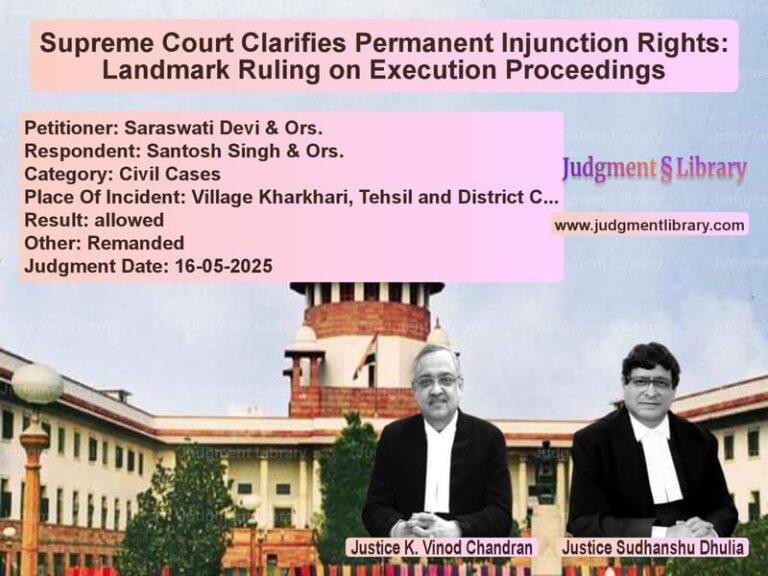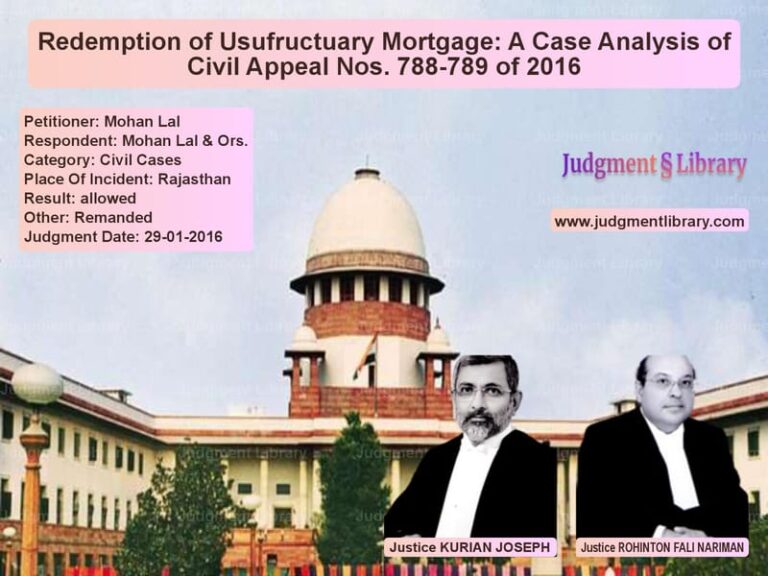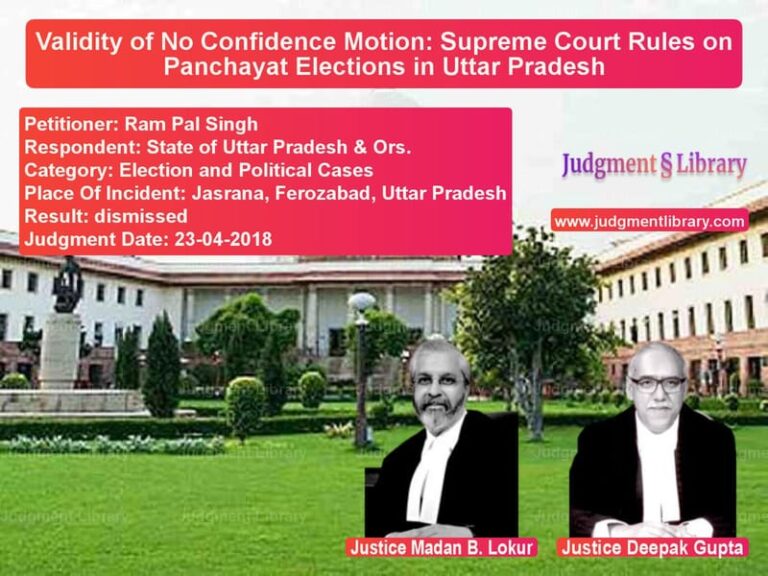Eco-Sensitive Zones and Mining: Supreme Court Upholds Ban on Commercial Mining
The Supreme Court of India, in the case of T.N. Godavarman Thirumulpad vs. Union of India & Ors., reinforced its commitment to environmental conservation by clarifying that all mining activities within Eco-Sensitive Zones (ESZ) are strictly prohibited, even if they are beyond one kilometer from the boundary of a Protected Area. The Court also reiterated that its earlier ruling of April 26, 2023, which banned mining within one kilometer of Protected Areas, applies uniformly across India.
This case arose when an applicant sought clarification on whether mining would be permissible if it was beyond one kilometer from the boundary of a Protected Area but still within an ESZ notified by the Ministry of Environment, Forest, and Climate Change (MoEF). The Court categorically rejected this argument, upholding the absolute prohibition on mining within ESZs.
Background of the Case
The dispute originated from an application filed by M/S Puntambekar Minerals, a mining company that had been granted a lease in 2005, subject to environmental clearances. The company contended that its mining operations were beyond one kilometer from the nearest Protected Area—Radhanagari Wildlife Sanctuary in Maharashtra—and should therefore be allowed.
The applicant relied on the Supreme Court’s judgment from April 26, 2023, which mandated a minimum one-kilometer buffer around all National Parks and Wildlife Sanctuaries where mining was banned. However, the applicant argued that this ruling did not specifically prohibit mining in areas that were beyond one kilometer but still within the ESZ.
Key Legal Issues
1. Whether mining can be permitted beyond one kilometer from the boundary of a Protected Area if it falls within an ESZ.
2. Whether the Supreme Court’s previous ruling on April 26, 2023, applies universally, including in cases where ESZ boundaries extend beyond one kilometer.
3. Whether specific ESZ notifications and MoEF guidelines must be followed strictly when regulating prohibited activities.
Arguments Presented
Applicant (M/S Puntambekar Minerals) Arguments
- The company’s proposed mining operations were beyond one kilometer from the boundary of the Radhanagari Wildlife Sanctuary.
- The Supreme Court’s judgment from April 26, 2023, only prohibited mining within one kilometer of a Protected Area, but did not explicitly restrict mining beyond this limit.
- Mining within an ESZ should be allowed if the Standing Committee of the National Board for Wildlife (SCNBWL) grants permission.
Respondents (Union of India & Amicus Curiae) Arguments
- Mining within ESZs is explicitly prohibited under MoEF guidelines of 2011 and various ESZ notifications.
- The Supreme Court’s April 26, 2023, judgment was misinterpreted by the applicant. The ruling intended to protect all ESZs and ensure that no mining takes place within these environmentally sensitive areas.
- The ESZ notification for Radhanagari Wildlife Sanctuary, issued on October 15, 2020, clearly prohibits commercial mining.
Supreme Court’s Observations
The Supreme Court, led by Justices B.R. Gavai and Vikram Nath, made the following key observations:
- The Court clarified that its April 26, 2023, ruling completely prohibits mining within one kilometer of a Protected Area, even if the ESZ boundary is smaller than one kilometer.
- The Court reaffirmed that MoEF guidelines of 2011 and specific ESZ notifications must be followed strictly. These regulations already prohibit mining within ESZs.
- The Court dismissed the applicant’s argument that mining within an ESZ could be allowed if it was beyond one kilometer from a Protected Area.
- The ruling emphasized that even if an ESZ extends beyond one kilometer, mining is still prohibited within the ESZ.
Final Judgment
The Supreme Court categorically ruled that:
- All commercial mining is prohibited within Eco-Sensitive Zones, even if they are beyond one kilometer from a Protected Area.
- Mining near National Parks and Wildlife Sanctuaries must comply with MoEF guidelines and specific ESZ notifications.
- The previous ruling from April 26, 2023, applies uniformly across all Protected Areas in India.
- The application by M/S Puntambekar Minerals was dismissed.
Implications of the Judgment
This ruling has wide-ranging implications for environmental law and mining regulations:
- Stronger Protection for Wildlife Sanctuaries and National Parks: The decision ensures that ESZs remain protected from commercial exploitation.
- Clarity on Mining Regulations: The judgment eliminates ambiguities about whether mining is allowed within ESZs.
- Binding Precedent: The ruling reaffirms that environmental protections take precedence over commercial interests.
- Impact on Future Mining Leases: Mining companies must strictly adhere to ESZ guidelines and cannot claim exceptions.
Conclusion
The Supreme Court’s ruling in T.N. Godavarman Thirumulpad vs. Union of India is a landmark decision that reinforces India’s commitment to environmental protection. By prohibiting mining within Eco-Sensitive Zones, the Court has strengthened safeguards against ecological damage and reaffirmed that conservation laws must be strictly implemented.
Read also: https://judgmentlibrary.com/supreme-court-overrules-ngt-order-on-land-development-near-teliya-talab/
This ruling ensures that mining activities will not encroach upon fragile ecosystems, preserving them for future generations. With this judgment, the Supreme Court has sent a strong message that environmental sustainability takes precedence over commercial exploitation.
Petitioner Name: T.N. Godavarman Thirumulpad.Respondent Name: Union of India & Ors..Judgment By: Justice B.R. Gavai, Justice Vikram Nath.Place Of Incident: Radhanagari Wildlife Sanctuary, Maharashtra.Judgment Date: 28-04-2023.
Don’t miss out on the full details! Download the complete judgment in PDF format below and gain valuable insights instantly!
Download Judgment: t.n.-godavarman-thir-vs-union-of-india-&-ors-supreme-court-of-india-judgment-dated-28-04-2023.pdf
Directly Download Judgment: Directly download this Judgment
See all petitions in Environmental Cases
See all petitions in Judgment by B R Gavai
See all petitions in Judgment by Vikram Nath
See all petitions in dismissed
See all petitions in supreme court of India judgments April 2023
See all petitions in 2023 judgments
See all posts in Environmental Cases Category
See all allowed petitions in Environmental Cases Category
See all Dismissed petitions in Environmental Cases Category
See all partially allowed petitions in Environmental Cases Category







